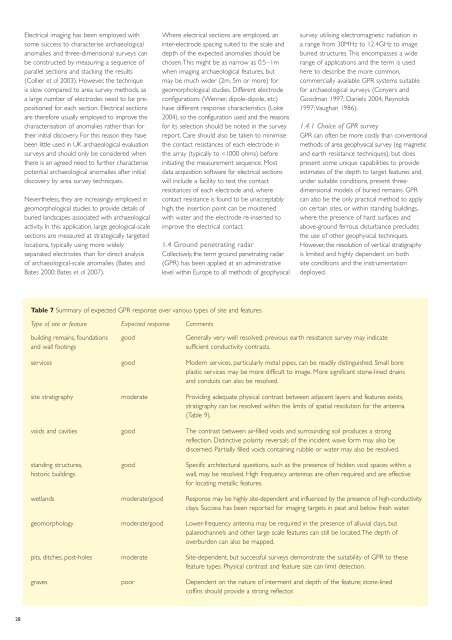Geophysical Survey in Archaeological Field ... - English Heritage
Geophysical Survey in Archaeological Field ... - English Heritage
Geophysical Survey in Archaeological Field ... - English Heritage
You also want an ePaper? Increase the reach of your titles
YUMPU automatically turns print PDFs into web optimized ePapers that Google loves.
Electrical imag<strong>in</strong>g has been employed with<br />
some success to characterise archaeological<br />
anomalies and three-dimensional surveys can<br />
be constructed by measur<strong>in</strong>g a sequence of<br />
parallel sections and stack<strong>in</strong>g the results<br />
(Collier et al 2003). However, the technique<br />
is slow compared to area survey methods, as<br />
a large number of electrodes need to be prepositioned<br />
for each section. Electrical sections<br />
are therefore usually employed to improve the<br />
characterisation of anomalies rather than for<br />
their <strong>in</strong>itial discovery. For this reason they have<br />
been little used <strong>in</strong> UK archaeological evaluation<br />
surveys and should only be considered when<br />
there is an agreed need to further characterise<br />
potential archaeological anomalies after <strong>in</strong>itial<br />
discovery by area survey techniques.<br />
Nevertheless, they are <strong>in</strong>creas<strong>in</strong>gly employed <strong>in</strong><br />
geomorphological studies to provide details of<br />
buried landscapes associated with archaeological<br />
activity. In this application, large geological-scale<br />
sections are measured at strategically targeted<br />
locations, typically us<strong>in</strong>g more widely<br />
separated electrodes than for direct analysis<br />
of archaeological-scale anomalies (Bates and<br />
Bates 2000; Bates et al 2007).<br />
Where electrical sections are employed, an<br />
<strong>in</strong>ter-electrode spac<strong>in</strong>g suited to the scale and<br />
depth of the expected anomalies should be<br />
chosen.This might be as narrow as 0.5–1m<br />
when imag<strong>in</strong>g archaeological features, but<br />
may be much wider (2m, 5m or more) for<br />
geomorphological studies. Different electrode<br />
configurations (Wenner, dipole-dipole, etc)<br />
have different response characteristics (Loke<br />
2004), so the configuration used and the reasons<br />
for its selection should be noted <strong>in</strong> the survey<br />
report. Care should also be taken to m<strong>in</strong>imise<br />
the contact resistances of each electrode <strong>in</strong><br />
the array (typically to

















